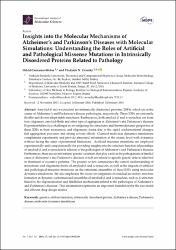Insights into the molecular mechanisms of Alzheimer's and Parkinson's diseases with molecular simulations: understanding the roles of artificial and pathological missense mutations in intrinsically disordered proteins related to pathology
Özet
Amyloid-beta and alpha-synuclein are intrinsically disordered proteins (IDPs), which are at the center of Alzheimer's and Parkinson's disease pathologies, respectively. These IDPs are extremely flexible and do not adopt stable structures. Furthermore, both amyloid- and -synuclein can form toxic oligomers, amyloid fibrils and other type of aggregates in Alzheimer's and Parkinson's diseases. Experimentalists face challenges in investigating the structures and thermodynamic properties of these IDPs in their monomeric and oligomeric forms due to the rapid conformational changes, fast aggregation processes and strong solvent effects. Classical molecular dynamics simulations complement experiments and provide structural information at the atomic level with dynamics without facing the same experimental limitations. Artificial missense mutations are employed experimentally and computationally for providing insights into the structure-function relationships of amyloid- and -synuclein in relation to the pathologies of Alzheimer's and Parkinson's diseases. Furthermore, there are several natural genetic variations that play a role in the pathogenesis of familial cases of Alzheimer's and Parkinson's diseases, which are related to specific genetic defects inherited in dominant or recessive patterns. The present review summarizes the current understanding of monomeric and oligomeric forms of amyloid- and -synuclein, as well as the impacts of artificial and pathological missense mutations on the structural ensembles of these IDPs using molecular dynamics simulations. We also emphasize the recent investigations on residual secondary structure formation in dynamic conformational ensembles of amyloid- and -synuclein, such as -structure linked to the oligomerization and fibrillation mechanisms related to the pathologies of Alzheimer's and Parkinson's diseases. This information represents an important foundation for the successful and efficient drug design studies.

















